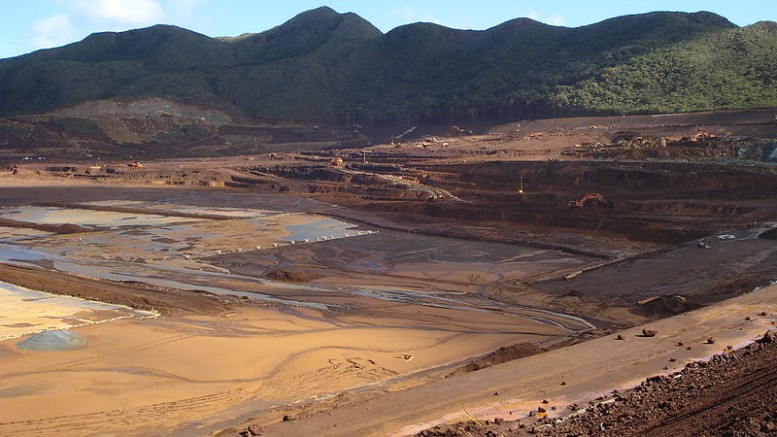VANCOUVER — With nickel prices up almost 40% so far in 2014, a suspension at Vale’s (NYSE: VALE) Goro nickel–laterite mine in New Caledonia has pushed the price to a two-year high.
The Goro mine has limited impact on global nickel supplies whether it runs or not, so a stable metal market would react little to the suspension. But because the nickel market is far from stable, the Goro news fuelled a fire that has heated up nickel for months.
Indonesia started the fire in January when it banned unprocessed ore exports, including nickel ore. For years China and Japan have imported raw nickel laterite ore from Indonesia and turned it into nickel pig iron (NPI), a cheaper alternative for steelmakers to pure nickel. The trade amounts to 450,000 tonnes a year, or almost a quarter of the 2-million-tonne global annual nickel market.
The export ban is intended to spur local processing and capture more of the metal’s value domestically, but it will be years before Indonesia has NPI production capacity.
In the meantime, NPI producers in China and Japan are working through the Indonesian ore they stockpiled last year, when rumours of the pending export ban gained momentum. The stocks are keeping the nickel market balanced this year, but once they are depleted NPI producers will be stuck, as there is no ready alternative to Indonesian ore. There is some nickel laterite mining in the Philippines, but production there is a shadow of Indonesia’s 450,000 annual tonnes.
The only hope for NPI producers is for the Indonesian government to backtrack on its export ban, but the odds of that happening in the near-term are slim. For one, until a new president takes office in October, the country arguably has a lame-duck government. Secondly, while a group of disaffected businessmen in Indonesia are lobbying to have the ban overturned, the measure has support from most political parties and from traditional international nickel miners and producers, who see no problem with higher prices.
It seems a quarter of the world’s nickel supply has indeed disappeared for some time. The result? A sudden, sharp market shift.
All last year nickel was in a bear market. Prices languished below US$14,000 per tonne, and at least a third of the world’s nickel producers were losing money. Adding to the misery, several large new mines set into motion in the last nickel bull market of 2007 were primed to enter production and add to an oversupplied market.
On Jan. 12 Indonesia’s export ban abruptly flipped the nickel market from oversupply to supply crunch. On top of that, many of the big new nickel mines are struggling.
Glencore Xstrata (LSE: GLEN) is reassessing its 26,000-tonne annual guidance after power supply problems and an extended maintenance stoppage limited output at its huge Koniambo project to just 1,000 tonnes in the first quarter. In Brazil, Vale’s Onca Puma ferronickel mine is ramping back up after a furnace blowout stopped operations for a year. Furnace problems are also keeping output at Anglo American’s (LSE: AAL; US-OTC: AAUKY) Barro Alto project well below full capacity.
Last year these setbacks were viewed positively: each shutdown held up a flood of supply into a saturated market. Now the market needs these mines to fill the massive gap that Indonesia’s ban created.
As long as that gap persists, news of nickel supply successes or disruptions will likely keep influencing the prices.
Vale’s suspension at Goro after an effluent spill is not unexpected — Goro has been problem-plagued since operating in 2011. And the shutdown may not be for long: the company is waiting to hear from local authorities about a timeline to resume operations.
Nevertheless, on the Goro shutdown news, three-month nickel on the London Metal Exchange surged 6.1% in intraday trading on May 8 to reach US$19,786 per tonne — its highest level since March 2012.
The rise continued the next day: on May 9 nickel reached US$20,500 per tonne, marking a gain of US$1,900, or 10.2% in two days.
Nickel prices can swing wildly because the nickel market is small and thinly traded, and therefore easily disrupted. For example, in the 18 months leading up to May 2007 the price of nickel quadrupled, rising from below US$12,000 per tonne to above US$50,000 per tonne. Eighteen months later it was back below US$10,000 per tonne.
It is this reactionary nature that makes nickel sensitive to unsurprising news, like the suspension of a mine that has seriously underperformed since it started operating three years ago.
Goro’s woes epitomize the problems with high-pressure acid leaching, a relatively new technology to treat laterite nickel ore. Problems with the acid plant took the mine offline for almost half of 2012. Effluent-management issues halted things for another six weeks in 2013.
So suspensions at Goro are not unusual. In fact, in three years of operation the mine — officially rated to produce 58,000 tonnes annually — has only produced 26,000 tonnes in total. As such, Vale’s projection that Goro would produce 40,000 tonnes in 2014 was already optimistic.
And even if Goro achieves that goal, its output feeds into a global market of 2 million tonnes. Goro is not yet major nickel-market player, but when supplies are tight, it seems even a small disruption can make big waves.


Be the first to comment on "Goro suspension pushes rising nickel price to two-year high"